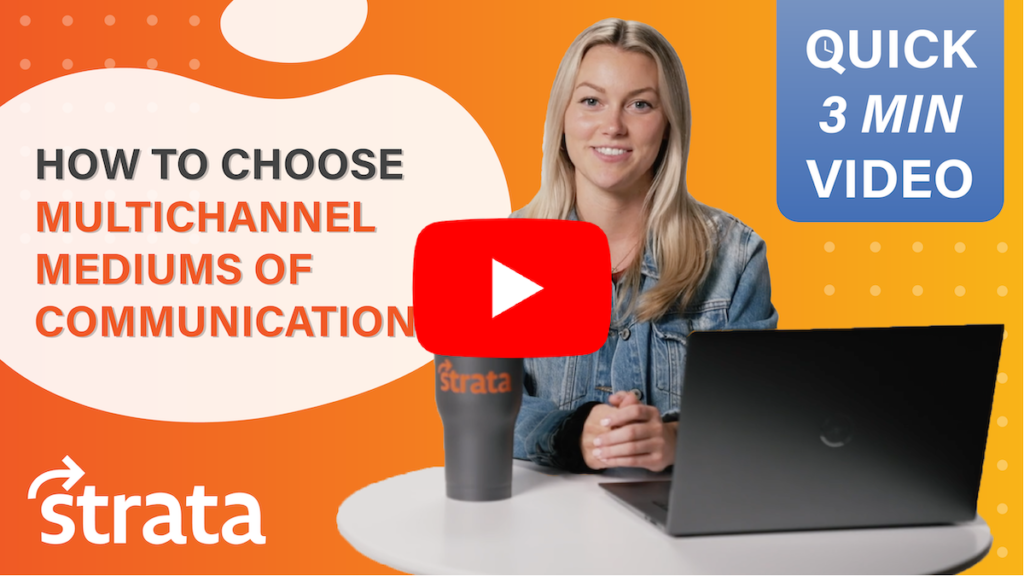A Strata YouTube Channel Original
Creating a personally relevant multichannel campaign can be difficult without proper preparation and guidance. Luckily, in this blog, featuring our most recent YouTube video of our Multichannel Marketing series, we go over some marketing personalization statistics, how to create a personalized, cohesive, and seamlessly relevant journey across multiple channels, and ways to better know who your buyers are.
The key to starting is to understand who your audience is and their specific buyer journey. Once you collect this data, it’s time to personalize and make sure the content you’re putting in front of them is relevant.
Map Out Your Customer Journey
When creating the perfect multichannel campaign for your audience, take a look at who your buyers really are and then work backwards to figure out how they became a customer. What high-value acquisition channels did these customers use? Which customers have strong LTV (lifetime value)? Talk to your customer service team and your customers. Once you organize and map that out, you’ll have a much easier time figuring out where the problems are, and where objections are coming from. And finally, discover where customers dropped off in the funnel. Put all of this together, and you’ll have a clear look at the journey your customers take and how you can improve your connections with them.
Establish Your Data
When we say establish your data, we’re talking way more than first names and company names. While those are important – that’s not the personalization customers are looking for these days. You’ll want to start partnering with a company (or using software) that can help you gather info like real-time, on-site behavior, online and offline conversion history, geographic location, product affinities, and device activity. All of this will help you develop a strategy that’s consistent and relevant from one channel to the next.
Ultimately, there’s no one-size-fits-all personalized experience – that’s why customers crave it so much. To see what steps are next in establishing your personalized approach, click on the video below. You’ll hear our Marketing and Social Media Coordinator, Bridget, go through best practices. Or, if you’d like to discuss this concept with one of our multichannel experts, contact us today to get your next (or maybe even your first) multichannel campaign started.
To Keep an Eye on
As a marketing solutions company with lots of interest in innovation and change – we’re big on knowing what’s trending and what’s to come. 2021 was filled with a ton of new trends, some – because of changing times and innovation – others, because of big events and worldly occurrences. To stay ahead and prepare for the new year, we’ve looked into the top marketing trends – within design, print, and digital, to keep an eye out for in 2022.
2022 Design Trends
Visual Inclusion
Recent movements around the nation, and even the world, have sparked a broader portrayal of diversity and inclusion in visuals. When crafting your marketing, think about how you can show diverse people in a variety of ways – in your photography, graphics, and iconography. And, even more, think about including imagery of people that your target audience(s) can relate to.“The default for people icons and images are no longer white, male, and able-bodied. There is more representation from marginalized groups in marketing visuals.” The more open, inclusive, and inviting your marketing is, the more likely you’ll bring in a diverse range of interested (and trusting) customers.
Bold Backgrounds
Bold and bright backgrounds and backgrounds with patterns are on the rise. These types of backgrounds attract attention and stand out from the pack, among otherwise modern – and primarily dull, gray, or white – busy feeds and mailboxes. Try using a brighter, bolder background to stand out among other marketing materials. This tactic can be “quite stunning when paired with more simple typography or other design elements,”but, to make this trend work for you and your brand, “ensure that everything has a place and there’s good eye flow between elements.”
Unique & Fun Typography
The year 2022 will be all about typography that “breaks standards”, such as “one single letter…upside down, bigger or smaller, in a different font, or completely missing.” Forecasters expect “lettering that pushes the bounds of easy legibility, creating forms that are expressive in and of themselves.” This unique and rising design tactic can also make for more internationally understandable text and imagery that can be read from culture to culture.
Authentic Imagery
Authentic, realistic imagery that your audience can connect with is always important – but will be increasingly popular in 2022. People don’t want to see fake stock families and disingenuous product photos. They want to see real. “Even commercial photography is shifting to look more like snapshots for these projects” instead of planned, posed imagery. This tactic may be a little less polished and intentional, but it works, because it’s relatable. “More authentic imagery is not amateurish; it’s just a different style.” Yet, this doesn’t mean taking blurry or “thrown together” photos. It means shooting high-quality photography that’s just a bit more casual and realistic to real, day-to-day life.
2022 Digital Marketing Trends
Conversational Marketing
This will be a big one for 2022, as it’s already been on the rise for quite a few years. Why? People want to connect with, and relate to, real people. And, they want fairly immediate responses from those real people. Customers feel more connected with and trusting of companies that tell their story, as well as the stories of their products. They want to hear and see real life examples of what the product has and does, and what sets it apart.
A recent study found that 41.3% of consumers use conversational marketing tools before making purchases. “Unlike traditional strategies, this form of marketing is now available across multiple channels, allowing brands to meet customers on their terms: on the devices, platforms and time schedules that suit the customer best.”
Read more about customer communication and relatability, here.
Video Marketing
This trend isn’t new, and is likely to continue in popularity for the next 5-10 years. It’s no surprise to us (and likely not a surprise to you) that 61% of marketers see video as a “very important or extremely important” part of their marketing strategy. It’s a useful tactic not only because of its visual appeal and high rate of easily digestible content, but because it can be republished on several platforms, and cut and manipulated for repurposing. A recent study recorded that “84% of consumers have been convinced to purchase a product after watching a video.”
To read more on video marketing, click here.
Interactive Content
This year, there will be a noticeable marketing shift from “traditional text-based content toward dynamic, engaging content” like quizzes, augmented reality, polls, 360-degree videos, and more. These tools give customers a more memorable connection with both the product and the company, and get them involved with the brand – not just get them to see it. In fact, 91% of customers are interested in seeing more content they can interact with.
First-Party and Zero-Party Data
We’ve talked a bit about this topic before in a fairly recent blog post, and this trend is sure to skyrocket into 2022. This year, “first-party cookies will force marketers to be mindful of the data they collect and how they use it,” primarily because companies can now only use their own collected data. This also means that companies will need to be much more authentic and transparent with their customers. Along with first-party data, zero-party data – data given to a brand or company directly from the consumer, will also be a key focus. Some examples of ways to acquire this data are through surveys, forms, or email.
2022 Print Marketing Trends
Combining Print & Digital
This particular trend – we’re very well-versed in. Combining print and digital can do wonders for your campaigns, meeting your customers with mulitple touches on and offline. A great example of this combination is using a personalized URL and QR code on a printed piece. QR codes on print marketing not only give customers an easy way to get to know your company better, but can be vehicles to get customers to purchase or sign up for a program – immediately. These types of combination tactics are flexible, dynamic, and cater to many differing age groups.
Creative Customer Personalization
Also, a great online or offline tool? Personalization. When your company caters to a specific type of audience, or even specific customers rather than a blanketed group, you’re more likely to meet customer’s needs and turn them into loyal ones. Additionally, personalization can be cost effective. Why’s this? In order to personalize, you can’t target everyone – just the right ones.
Direct Mail
Lastly, not a new or surprising trend to us, direct mail will continue to grow in popularity in 2022. “With the content marketing boom and remote working becoming the new normal, many consumers have become ‘numb’ to digital marketing campaigns.” So, if you haven’t, why not give direct mail marketing a go? Trying out this re-emerging marketing trend could bring a ton of new customers to your site, as 70% of people engage with a brand online after receiving their direct mail.
Read more on why direct mail is so impactful, here.
Interested in ramping up your marketing in 2022 using one or more of these solutions? We can help! Contact the experts at Strata, today.
A Strata YouTube Channel Original
In this ever-changing market, not even a marketing genius can accurately gauge performance of a multichannel campaign without organized, analyzed data across channels. That is why setting and tracking key performance indicators (KPIs) is very important. Follow along as we walk you through a few things to keep in mind when establishing and understanding KPI’s for your multichannel campaign.
What’s a KPI?
Like we said above, KPI stands for key performance indicator. It’s a quantifiable measure of performance over time for a specific goal. In this case – that goal is multichannel marketing success. KPIs lay out marketing goals in the form of specific milestones to calculate progress and insights, and these insights help marketers make better decisions. In order for KPIs to be successful and helpful, a marketer or team of marketers needs to handle and record analytics from several touch-points. Without KPIs there’s no way to accurately and effectively measure the efficiency of your multichannel performance.
KPIs at Their Core: Layer One
There are two levels of KPIs for multichannel campaigns. The first layer is the component layer, and it’s used to analyze the individual components of a campaign. This layer helps establish realistic goals for the campaign and provides low level insight to analyze and optimize as your campaign progresses. Conversion rates vary by standards like industry and medium, which are easily researchable.
Yet, actual conversion rates have huge ranges based on the nature of your call to action – like your messaging, imagery, and your audience, and which segment of the funnel they’re in. If your campaign’s messaging can be considered “industry standard”, save yourself some time and use an average conversion rate, even if it looks low.
Further into KPIs: Layer Two
Want to learn about the second layer of KPIs, and how to establish them for your next multichannel campaign? Click on the video below and hear more from our Director of R&D, Harrison. Or, if you’d like to discuss this concept with one of our multichannel experts, contact us today to get your next (or maybe your first) multichannel campaign started.
What’s the Real Deal?
There’s a ton of information out there about multichannel marketing – and it can be hard to sift through. You probably often find yourself wondering, what’s real, and what’s myth? You’re not alone. Many marketers end up hindering their own multichannel efforts by believing a lot of these circulated misunderstandings, but with our help, you don’t have to. Today, we’re looking at three of the most common misconceptions around multichannel marketing, and – as experts in the area, letting you in on the real deal.
Myth 1: Multichannel Marketing is “Too Expensive”
There are a ton of marketers and organizations out there that have yet to try or implement multichannel marketing because it’s “too expensive” or “over budget”. It may cost slightly more than your generic, on-touch marketing, but it’s important to consider the benefits and weigh the cost versus the potential (and often guaranteed) ROI. There’s proof out there that many businesses end up getting much greater ROI from multichannel marketing, making the price worth it. Plus, it’s estimated that companies with optimal multichannel campaigns experience “customer retention rates of 89%, compared to an average of 33% for those businesses with weak multichannel engagement”. It’s all about how you use your budget, and allotting it to the marketing practices and programs that will yield the highest return.
Myth 2: Multichannel Solutions “Benefit Only the Customer”
It’s a common misconception that multichannel marketing is great for meeting customers at many touchpoints, but that it’s overwhelming and inconclusive for the company using it. This could not be further from the truth. Multichannel marketing is not just a one-touch process, and that’s what makes it unique and effective. Although it may seem like a lot at first (engaging with customers on several platforms such as direct mail, social, and website) it’ll be extremely helpful in forecasting and planning a company’s marketing strategy in the long run. Multichannel marketing benefits customers by providing them with relevant, personable, and consistent content, but also benefits your company by building brand awareness, loyalty, and trust within consumers and by compiling data and analytics for a complete picture of your audience’s customer journey.
Like we said, it may seem like a lot at first, but over time, you’ll get a clear picture of what channels and touchpoints work best for your company and reach the most customers, what channels and touchpoints don’t, and where and when it’s best to reach your target audience(s).
Additionally, multichannel marketing helps your employees improve customer service and build more personal and personalized relationships with customers. For example, while communicating with a customer at a certain touchpoint, your customer service representative can see exactly what contact points the customer has already accessed, as well as the information they’ve received or provided to your company. This relationship that multichannel marketing fosters not only creates less frustration and unawareness for the customer – but for the company as well. In turn, multichannel marketing reduces staff turnover, and ensures that you keep your most talented employees. It can also reduce staff errors and build a better brand reputation for your company as a whole
Myth 3: Multichannel Marketing is “Hard to Implement”
We’ve heard this one a lot. “Multichannel marketing is so involved,” or “I just don’t have time for all that.” Here’s the thing…multichannel marketing is only as hard as you make it. There are a lot of channels out there to reach your potential customers (website, in-store, catalog, e-mail, TV, text, blog, mail…the list goes on), but that doesn’t mean you have to use all of them. Plus, if you stick with your brand standards and ensure all of your touchpoints are connected and unified, you can use similar (if not the same) content, design, colors, and calls-to-action across channels, making the process much easier.
The best way to get started without getting overwhelmed is to create a plan. A great trick for quick planning is “RACE”; Reach, Act, Convert, and Engage. Make sure you’re hitting all of these parts of the process to ensure you’re connecting with and converting your audience, and getting the most out of your multichannel marketing.
Lastly, if you still feel you’re in over your head, or just really want to focus on other parts of your business, don’t hesitate to partner with experienced multichannel marketing experts. Research who you want to partner with so that you’re aware of what to expect and what they’ll expect from you in terms of budgets, end goals, and experience levels.
We hope we’ve eliminated some of your worries, answered some of your questions, and provided you with a bit of confidence in multichannel marketing. To get started on your next (or maybe your first) multichannel campaign, or learn more about how we can help, feel free to contact us.
Looking for more information on multichannel marketing and how to effectively launch a campaign? Visit our YouTube channel for quick tips and tricks from the experts at Strata.
With a Combination of Direct & Digital Marketing (and the Right Partner)
Maybe you’ve heard about the paper shortage, or maybe you’ve experienced it first-hand. Either way, it’s something you should know about, as it’s seemingly becoming a bigger issue in our field day by day. But, before we sound all doom and gloom, we do have good news. Although it’s a current issue we’re facing, there are ways to combat it and work around it. In this blog, we’ll walk you through what exactly is causing the shortage, what it means for us (and you), and how we all can continue business as (almost) usual.
What’s Happening with the Paper Shortage?
So, what’s really going on? Well, there are many shortages going on right now – primarily due to all of the craziness that’s ensued over the past few years. The pandemic has been the primary factor in most shortages, from toilet paper to manufacturing products, and everything in between. Something else that’s suffering? Lumber, and in turn – you guessed it – paper.
Back in 2020, the demand for paper dropped by “up to 75% in some segments” due to drops in education and office space usage. Because of this, “paper mills reduced or curtailed production…which caused inventory to drop to levels which have not been seen previously.”
More recently, there’s been a “convergence of Canadian lumber tariffs, increase in demand for home remodeling and building of homes brought on by the pandemic, and hiccups in supply related to transportation.” From home projects to home purchases, we’re now using a lot of wood. More wood demand has called for changes in processes for these previously idle lumber suppliers, which has slowed production – and even worse, transporters impacted by Covid-19 risks has made for fewer available drivers to carry out shipments from mills and shipping ports.
Generally, one thing has led to another, causing a domino effect that’s triggered lumber prices to skyrocket, and has disrupted several industries.
What Does This Mean for Marketers & Print Projects
Yes, the paper shortage is concerning, but it doesn’t make print and direct mail marketing impossible or any less effective. With that said, don’t go overboard. Be aware of the materials you’re using and try to keep a close eye on the balance of supply and demand. While the lack of resources is a hurdle, the shortages are actually giving printers and marketers an opportunity to get creative with project execution by combining print with digital and trying new outreach possibilities.
How Can We Combat the Shortage?
There are several ways to work around the current hurdles we’re facing. The first? Using more digital technology wherever possible (and effective) – like QR codes, for example – to cut back on the paper needed to communicate a message or tell a story. Not only can QR codes and PURLs, or other tools help you use less paper, but they can help you more effectively track, monitor, and enhance your campaign. You can also try supplementing your multiple direct mail touches with other tools like digital ads and emails. A multichannel approach is always more impactful than a single channel, anyway.
Next, look into making your mailers, flyers, and other print marketing materials more cost effective by using a smaller paper weight, or stand out in the mail with a smaller but more uniquely shaped piece.
Lastly, look to work with a company with paper buying power and ample experience. They’ll be aware of the current issues, and will understand what’s best for your company’s marketing needs.
Reach Out
When it comes to shortages of any kind, remember to be patient and plan ahead. The paper shortage most likely won’t be around forever, but the more flexible you can be, the more you can mitigate the issue. After reading this, we hope you’re feeling a bit more knowledgeable of the current shortage as well as what you can do to combat it. If you’re interested in learning more about how Strata’s working through the shortage with our client (and on our personal projects), or are looking to work with us on your next multichannel marketing campaign, feel free to reach out.
A Strata YouTube Channel Original
Choosing the right multichannel campaign mediums can be difficult if you don’t have a good starting foundation and the right tools. That’s why, in our most recent YouTube video, we walk you through the key things to keep in mind when making this decision, and how to pick channels that best fit your company’s marketing needs.
Evaluate Your Brand & Customers, First
Before you even look at where your audience is and what they want, look at your own brand, brand voice, offerings, and then your target audience. Once you have these nailed down, then you can think about your customers – because if you understand your customers, you can understand where it’s best to communicate with them. Get to know your customers on a deeper level through data and tracking so you can develop personas and demographics, and fully recognize their pain points, wants, and needs. Test and measure tactics, update and reaudit your customer experience, ask for customer feedback – whatever you need to do to truly know your audience and therefore get the most out of your multichannel campaign. After all, 86% of customers are willing to pay up to 25% more for products and services just to have a better customer experience. Once you know your audience, then, and only then, can you figure out exactly where to meet them on their multichannel journey.
If you want to know what comes next in choosing the right mediums of communication for your multichannel marketing campaign, click on the video below and hear more from our Marketing and Social Media Coordinator Bridget. Or, if you’d like to discuss this concept with one of our multichannel experts, contact us today to get your next (or maybe even your first) multichannel campaign started.
A Look at Some of Our Favorite Customer-Focused Campaigns
Although we could write several blogs about all the great marketing campaigns that inspire and motivate us to be the best marketers possible and make the most effective material – in this blog, we’re looking at a few that we really admire because of how relatable and real they are. We’ll be breaking them down, thinking through what made them so successful, and in turn – helping you brainstorm your next campaign. Follow along as we dive into these customer-centric campaign leaders.
Apple’s #ShotoniPhone Campaign

No matter where you’re located – you’ve likely seen this one around town. On billboards, buses, signs, or online. iPhone and Apple’s popularity is pretty known, but what we didn’t know when the iPhone first became popular was that it would eventually completely replace the digital camera. And that’s what this campaign shows; that you can take photos with your iPhone that are as beautiful as a camera that would cost you thousands. That’s great and all, but that alone would not convince people of today. So, why’s this campaign so successful? It gets real people involved. It’s relatable. The photos are not only from real Apple customers – but include their names. If someone wanted to, they could look up the name of the person in the bottom corner associated with taking the photo and learn more about who that person is. The best part? Not all of these people are photographers, showing that anyone could use the iPhone to take great photos. This tactic is pretty genius and builds trust – as no one would really care if it was simply a generic photo that easily could have been taken on a Canon. “According to various studies, over half (51%) of Americans trust user-generated content more than other information on a company website and claim that it influences what they buy and where they buy it from.”
Coors Light’s #CouldUseABeer Campaign
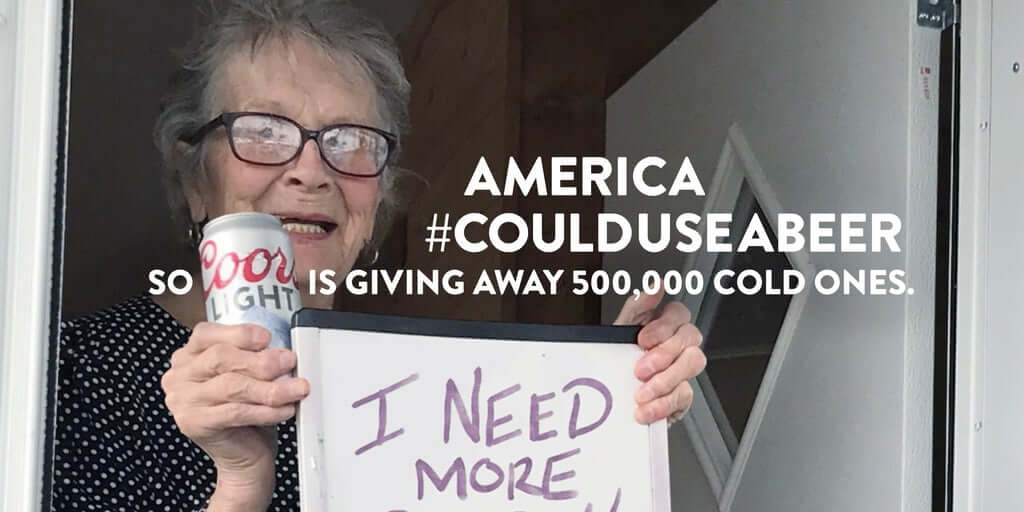
Another campaign that spoke to the general public and got them involved during a difficult time? Coors Light’s #CouldUseABeer. After a photo of a quarantined, 93-year-old woman asking for a beer went viral, Coors Light engaged with its audience by offering free six packs to anyone who was tweeted about (who – you guessed it, could use a beer). This tactic of giving away free items may seem pretty crazy, but it can go a long way. Although Coors Light gave away over 500,000 beers, their name was tweeted about again and again, which led them to trend, and boosted their reputation in a time of need.
American Apparel’s Direct Email Marketing
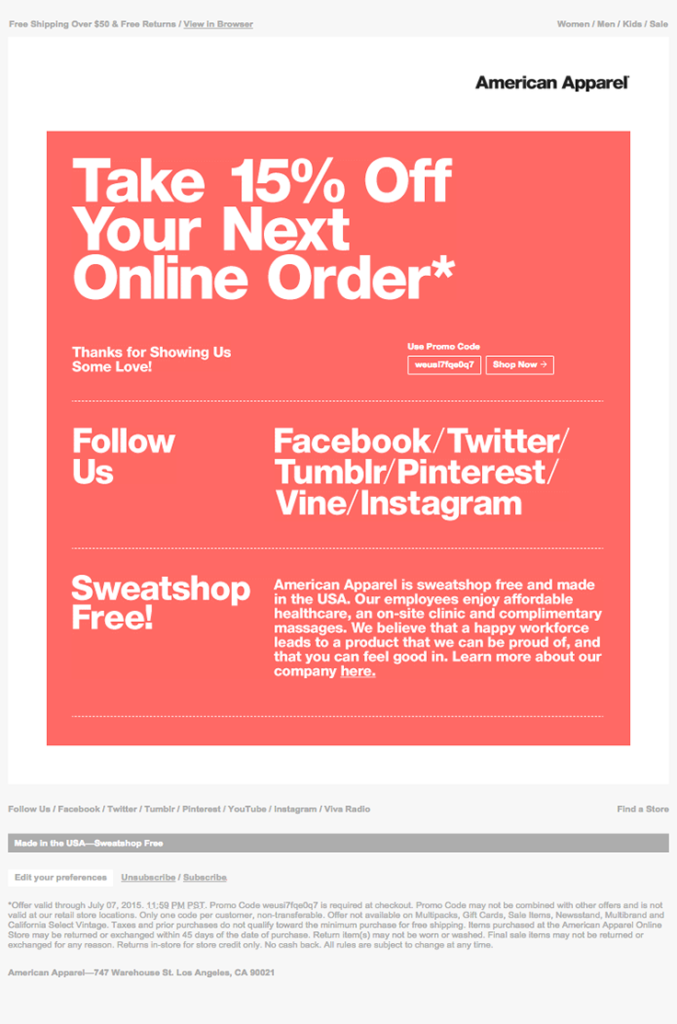
Known for being trendy and modern, American Apparel is no stranger to effective, up-to-date, customer-centric marketing. We’re specifically impressed with their to-the-point email marketing. No frills, no fluff – just what the customer wants (sales, discounts, and freebies). American Apparel always ensures that there’s no guesswork for their customers. Simple and sleek, their emails are call-to-action forward without being in-your-face.
Mercedes’ “Like You” Campaign

How do you relate a high-end brand to a broader audience of customers? Relate it to them, literally. Mercedes’ “Like You” campaign did just that. Called to several different types of audiences with phrases like, “Detail-obsessed, like you”, “Groundbreaking, like you”, “Original, like you” and “Curious, like you”. And not only was this phrasing compelling, but consistent. For the span of the campaign, potential customers could find the phrasing on billboards, signs, online ads, and on tv. The consistency was key, in that potential customers began to associate themselves with the brand and possibly even buy a Mercedes.
Airbnb’s Use of User Generated Content

Similar to Apple’s tactic, Airbnb uses the photos, videos, and feedback of its customers in its campaigns to promote beautifully classic or uniquely interesting places to stay. “Millennials spend 30% of their media time (5 hours/day) engaged with user-generated content (UGC). Coincidently, this is the same generation that drives Airbnb’s success in the sharing economy.” Airbnb keeps things personal and personalized by including its audience, which facilitates a happy and loyal community of customers.
Coca Cola’s Share a Coke Multichannel Campaign
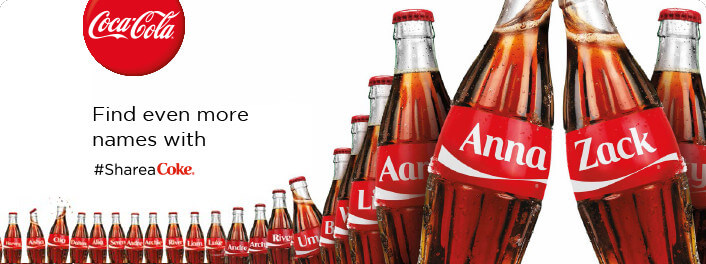
We all know this one. There’s nothing more personal than having your own name on a Coke bottle – which is exactly what Coca Cola did for its ongoing “Share a Coke” campaign. Whether you customize your bottle or simply find your name in store, you’re likely to share it with the world through text, email, on social, you name it (no pun intended)! And its rollout in 2011 sure worked in building brand awareness, boosting sales, and creating positive brand recognition, as “Young adult consumption increased significantly during the campaign, up by 7%, making 2011 the most successful summer ever. The campaign earned a total of 18,300,000-plus media impressions.”
Spotify’s #2020Wrapped Campaign
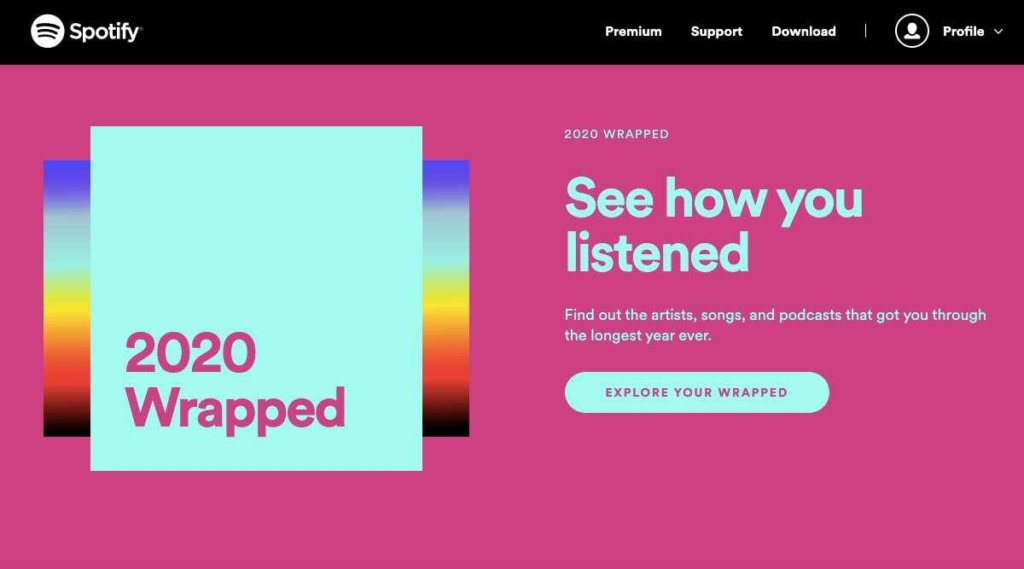
If you have any form of social media, you’ll likely remember this campaign flooding your feed, and maybe you even took part in it. At the end of 2020, Spotify allowed its customers to see their year of music with “2020 Wrapped”, which compiled their listening into a lovely array of photos and stats. Viewers loved seeing their personal data compiled into a nicely packaged marketing piece – and loved sharing their interests with others. Smart on Spotify’s end, because it not only gave them free marketing, but boosted their recognition.
So, What Have We Learned?
If you haven’t noticed, most of these campaigns share one key factor; relatability. How can you use relatability to create effective campaigns, too? Know your audience. Before even starting to brainstorm a campaign, make sure you’re fully aware of who, where, and when you’re targeting. And when you do start your campaign based off your findings, use that data and understanding to carefully craft consistent messaging that includes clear call-to-actions and personalized, catered content. Use hashtags, giveaways, QR codes, PURLs, BRCs, and more to engage with your audience and include them in your campaign. And, when and if appropriate, sprinkle in some humor.
Interested in making an impactful, relatable campaign that can help boost your company’s marketing efforts? Not sure exactly where to start? Look no further. Strata’s here to help. Contact us today to get the brainstorming started.
San Antonio, Here We Come!
At Strata, one of our favorite things to do is talk marketing. We’re problem solvers, and we pride ourselves on helping industries overcome their marketing challenges. With healthcare marketing being one of our many specialties, we’re excited to announce that the Strata team is heading back to the annual SHSMD Connections Conference in San Antonio, Texas from September 19th-21st, and we couldn’t be more excited!
SHSMD? What’s That?
For those who’ve never heard of SHSMD (aka the Society for Health Care Strategy & Marketing Development), it’s an AHA professional membership group that focuses on how the industry can evolve and change with new strategies, marketing, and technology, serving more than 4,000 members.
This year, SHSMD is celebrating the 25th anniversary of their annual “Connections” conference, and we can’t wait to connect with some of the industry’s best marketing and communications strategists. It’s been two years since we’ve been able to interact with these professionals in person, and we’re excited to be able to once again inform, challenge and validate their thinking, while also learning from the conference’s guest speakers from all over the country.
What We’re Looking Forward to & What We’re Bringing
This isn’t our first rodeo (even though it’s our first time going to Texas), as we’ve attended this conference for 20+ years. However, this will be our first time back with a refreshed look, thanks to our 2020 brand refresh. As marketing experts with almost 30 years of experience, we’re excited to bring our expertise to the show, and create some new, long-lasting relationships.
It’s clear that the healthcare landscape is evolving faster than ever, and to stay competitive, hospital systems need to start looking at marketing as a strategy rather than an afterthought. We plan to go into the show with an open mindset and to educate healthcare industries on the importance of New Mover Marketing and how SmartMove can help them achieve their patient acquisition goals.
If you don’t know who (or what) we do, Strata offers a wide range of client-driven solutions to help companies solve complex marketing and communications challenges. We’re a lot of things (innovators, go-getters, marketing experts), but we’re people first—and we know you are, too. That’s why we believe the best way to help a business achieve its marketing goals is by focusing on the people who work there.
Learn More
If you’re attending this year, stop by booth 216 to learn more about how Strata can help you with your marketing efforts. We can’t wait to meet you!
If you’re not attending the upcoming conference- no worries. Contact us today to discuss your own personal marketing plan from the comfort of your own home.
A Strata YouTube Channel Original
We’ve all heard the saying “know your audience” before, but what does it really mean, and how will it help you plan your next multichannel marketing campaign? In our most recent YouTube video, we dive into some tips & tricks for targeting your perfect multichannel campaign audience.
Really Know Your Audience
Before you even start your campaign, you need to nail down who your audience is and why you’re targeting them. Recent surveys show that 74% of consumers get frustrated when they receive content that has absolutely nothing to do with their interests, which is the main reason companies are quickly switching to multichannel marketing campaigns – designed to be customer-centric, provide a top-tier experience, and drive high ROI. But success still comes down to how well you know your audience, which is why it’s so important to create accurate customer personas. A persona is simply a fictional character that represents the ideals and motives of your target audience. Some common (and extremely useful) research tactics to create correct customer personas are researching buying habits, consumer preferences, search behaviors, and communication methods. Don’t limit yourself to just one persona if it’s useful to create more! You can utilize several different personas depending on how diverse your target market is. It’s important to think beyond your “classic customer,” and diversify your buyer profiles.
The Buyer Journey
Outlining and creating a framework for your buyer’s journey will dramatically affect your sales. Some key questions to ask yourself to understand their journey are:
- “What purchases are being made?”
- “Where are the purchases coming from?”
- “How are they making purchases?”
These questions will help you build a premium customer experience from campaign start to finish. The more data you’re able to acquire on their buying habits/decisions, the better you’ll be at mapping out their customer journey. After narrowing down your audience, you can better source all imagery, content, and workflows they’ll come across throughout the campaign.
Want to learn more about perfecting your multichannel marketing audience? Click on the video below to hear more on this topic from our Marketing and Social Media Coordinator, Bridget. Or, if you’d like to discuss this concept with one of our multichannel experts, contact us today to get your next (or maybe your first) multichannel campaign started.




